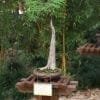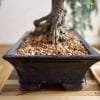Bonsai trees are lovely miniature specimens of their large cousins. Bonsai are susceptible to pests and diseases, as most of them grow in an outdoor garden rather than an indoor one. Some species, including quince, are more susceptible to disease as their root systems are weak and prone to damage. Harmful microbes enter through the damaged areas.
Citrus Longhorned Beetles
Citrus longhorned beetles are native to Korea, but introduced to the United States on bonsai plants. Woody plants, such as bonsai trees, are among the preferred hosts for this pest. Examine the inside of the bonsai for larvae during the winter months. Treating the problem at the immature stage can limit potential damage. Once the beetles emerge in late spring, at approximately 1 to 1-1/2 inches long, they will feed on the bark, petioles and leaves of your bonsai trees. The petioles are the delicate stems that grow leaves, as opposed to the thicker stems that produce petioles.
Twig & Tip Blight
There are more than 60 varieties of juniper (link to juniper page), and they are a popular choice for bonsai plants. When the needles start to turn brown and drop off the plant, or new shoots die when they emerge, then twig and tip blight might be the problem. This fungus infection usually results from warm weather and poor drainage. Prune all affected areas or the fungus will spread to the rest of the bonsai trees in the garden.
Red Spider
The red spider is a common pest in both indoor and outside gardens. Bamboo bonsai plants are susceptible to this mite, as it eats the foliage. In addition to the red coloring, other species of red spider mites are yellow, orange or even green. They mature in only three weeks and start spinning webs on the bonsai trees. Many are resistant to pesticides, so some gardeners introduce predatory mites, includingPhytoseiulus per-similus, to eradicate the problem. Gardeners might introduce one or two predatory mites per bonsai tree.
Cedar-Apple Rust
Cedar-apple rust can affect bonsai trees grown in the vicinity, up to ½-mile, of crabapple or apple trees. Wind carries the spores between the different varieties of trees. They attach to junipers and grow on the last two or three inches of the branches. Look for galls with orange tendrils. The tendrils produce the spores. Prune the damaged areas to control this disease.
Root Aphids
Root aphids attack Bald Cypress bonsai trees (link to bald cypress page). Since you cannot inspect the roots, examine the outer branches for signs of dying. As the aphids consume the roots, less nutrition reaches the branches, causing the ends to die. If not treated, the entire branch will die.
Spruce Spider Mite
Spruce spider mites affect several varieties of bonsai trees. They bite into the plant and consume its sap. Examine the bonsai plants for yellow spotting on the needles. The mites are usually too small to see without a magnifying glass, but you can see the yellow damaged sections. They prefer the cooler spring and summer months, so examine the bonsai trees for damage during these seasons. It might be difficult to identify an infestation during the summer when the spider’s natural predators feed on it. The spider mites will continue to reproduce and consume the sap, eventually killing the affected bonsai trees. Spray the affected trees with an insecticidal soap.
Pine Wilt Nematode
The pine wilt nematode feeds on the bonsai tree bark as well as the tissues of twigs. The beetles lay their eggs in freshly damaged areas of the bonsai plants. Pine wilt nematodes feed on the sap and young shoots, multiplying to a large population quickly. They can destroy the host plant during the first season of infestation. This nematode mostly exists in the eastern part of the country.
Caterpillars
Several species of caterpillars feed on the different varieties of bonsai trees. Some of the more voracious species include the dagger moth, geometrid, mourning cloak and webworm. The dagger moth and geometrid butterfly feed during their larvae stage on maple and oak bonsai trees. The mourning cloak butterfly consumes elms and willows during its larvae development. The webworm builds its nest at the end of the branch, feeding on every type of bonsai except conifers. Many types of caterpillars are regionally located, attacking a particular species of plant or tree within that part of the country.
Thrips
Thrips feed on woody plants, including bonsai trees. Biologists have currently identified 264 species, some as tiny as 1/25 of an inch. They eat the foliage, new shoots and flowers, leaving a trail of damage throughout the bonsai plants. Horticulturists have developed a blue sticky trap to catch the thrips. It is supposed to be more effective than the original yellow sticky traps. When you see evidence of infestation, consult your garden center for the best insecticide. The choice will depend on other plants in close proximity to the affected bonsai trees.
Snails
Snails can be a problem for tropical bonsai trees, including the Carmona species commonly called Fukien Tea. Common insecticides can damage the Fukien tea bonsai (link to Fukien Tea Bonsai page), so you might prefer to introduce a predator to solve the problem. If the infestation is in its earliest stage with only a few snails on a container plant, then removing them by hand is a possibility.
Powdery Mildew
Powdery mildew usually occurs when the bonsai tree is watered in the evening, allowing the leaves to remain wet for an extended period. Powdery mildew is more prevalent when the plants are located in an area without sufficient airflow to dry the foliage. It appears as tiny white granules, similar to flour. Remove the affected parts of the bonsai to stop its spread. Change the watering schedule to early morning, as the foliage will dry quickly with sunlight.


